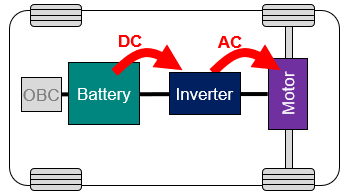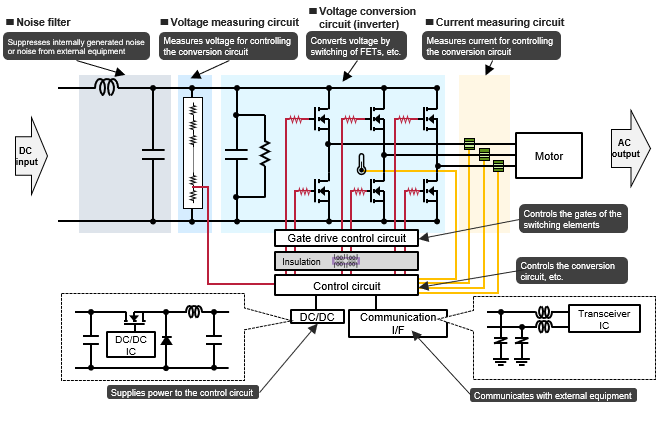2023-08-09
Application
Technical information
What Is an Inverter in an Electric Vehicle?
- DC/AC converter efficiently supplying power to motor -
An inverter is a device that converts direct current (DC), which is supplied from a battery, into alternating current (AC). A motor in an electric vehicle runs on this alternating current, which thus drives the wheels. To improve overall energy efficiency of the electric vehicle, the energy loss of the inverter should be reduced to the minimum. This article will discuss the functions and system configuration of the inverter, and will introduce electronic components that make up the inverter as well.
What is an inverter?
Brief description of the inverter
An inverter in an electric vehicle converts direct current (DC), which is supplied from the battery, into alternating current (AC). The inverter is indispensable because most traction motors incorporated in electric vehicles run on alternating current. The power output of the inverter is set in line with the power output of the motor (which ranges from 30 kW to 400 kW).

Usually, a single car carries one or two inverters. However, a car of in-wheel-motor type, whose wheels are each driven by individual built-in motors, needs inverters that feed these motors, respectively.
Motor types
Motors are roughly classified into brush motors and brushless motors. The brush motor is for use in small equipment. It runs on a DC voltage supply and is therefore relatively easy to control. The brushless motor is suitable for applications in which better energy efficiency is emphasized and fine tuning of the number of revolutions (rotating speed) is required. It is used in traction motor systems that cars need for travel. Since the brushless motor runs on alternating current, it needs an inverter that does DC/AC conversion.
| Motor type | Features | Supplied power, control |
|---|---|---|
| Brush motor |
|
Directly supplied with DC power Needs no control circuit or simple structure |
| Brushless motor |
|
Supplied with AC created from DC. → Needs an inverter Uses an inverter to control the circuit |
Trends in the market and demand for the inverter
As the number of electric vehicles on the market increases, the number of inverters incorporated in the cars will also increase. Meanwhile, a trend toward higher traveling performance creates a demand for a motor with higher power output, and the motor with higher power output needs an inverter with higher power output (high power). Electronic components making up an inverter are required to offer specific functions/performance for the future, which include "high power,” "highly resistant to heat,” and "small size/light weight.” The details of these requirements are as follows.
- High power
The inverter working with a motor with high power output needs to be a high-power inverter capable of high power output. Higher power output means a higher voltage (from 400 V, the current rated voltage, to 800 V, rated voltage for future high-power applications) and larger current. A semiconductor element, etc. making up the inverter, therefore, needs to handle such high voltage/current. - Highly resistant to heat
As electronic components get smaller and smaller, heat per unit area gets higher and higher. Giving an electronic component high resistance to heat prevents its degradation caused by self-heating or incoming heat from components nearby. - Small size/light weight
The high-power (high power output) characteristics of a component may result in an increase in its size and weight. In such cases, bulky components would affect the mileage of the car overall. As the power characteristics of components are increased, therefore, their size and weight need to be kept small at the same time.
Circuit configuration of the inverter
Overall configuration
The inverter is composed of the following components.
- Noise filter:Suppresses internal noise or noise from external equipment
- Voltage measuring circuit:Measures voltage for controlling the conversion circuit
- Voltage conversion circuit:Converts voltage by switching of FETs, etc.
- Current measuring circuit:Measures current for controlling the conversion circuit
- Control circuit:Controls the conversion circuit, etc.
- DC/DC converter:Supplies power to the control circuit
- Communication I/F:A communication circuit that communicates with external equipment

Individual circuits and components
Noise filter
The noise filter suppresses internally generated noise or noise from external equipment to prevent malfunctioning of the inverter.
In general, the filter combines a large inductor and a film capacitor together.
Noise filter: Film Capacitors (Automotive, Industrial and Infrastructure Use)
POINT- ❶ High reliability: The film capacitor offers high resistance to humidity and to thermal impact, and conforms to AEC-Q200.
- ❷ High safety: With its security mechanism (fuse), the film capacitor ensures high safety. (The circuit is put into an opened state in failure mode.)
Voltage measuring circuit
The circuit measures an input voltage for carrying out control of the voltage conversion circuit.
In general, it measures a voltage across both ends of resistances connected in series.
Voltage measurement: Chip resistor (high-precision chip resistor)
POINT- ❶ The chip resistor with a thin-film structure offers a small resistance tolerance and a low TCR, thus contributing to high-precision control of the output characteristics of the circuit.
Voltage conversion circuit
The circuit converts voltage by switching elements.
The switching elements' switching actions cause the input voltage to fluctuate, thus creating noise. The large film capacitor smooths out voltage fluctuations to suppress noise. Energy accumulated in a large film capacitor must be released after the car stops. Otherwise, the inverter may malfunction. For this reason, a resistor is usually connected to the capacitor to let it release accumulated energy.
The switching elements switch on and off to make voltage conversion, but these switching actions create noise. To suppress this noise, gate terminals of these switching elements are made up of resistors.
High-power operations put the switching elements, etc., in a high-temperature state. To prevent a failure of such elements whose temperature may rise above the upper limit temperature, generally, the temperature of the elements is measured with an NTC thermistor.
Noise suppression, voltage smoothing: Film Capacitors (Automotive, Industrial and Infrastructure Use)
POINT- ❶ High safety: With its security mechanism (fuse), the film capacitor ensures high safety. (The circuit is put into an opened state in failure mode.)
- ❷ Small size: By using a high-withstand-voltage PP film, the film capacitor is reduced in thickness and is therefore reduced in overall size.
- ➌ High power output: Panasonic’s original vapor deposition technique reduces self-heating by the film capacitor (low ESR), allowing the inverter to perform high power output operations.
Suppressing gate-driving noise by the switching elements, electric discharge by the film capacitor: Chip resistor (small and high-power chip resistor)
POINT- ❶ With its original resistance pattern, electrode structure, etc., the chip resistor is small in size and yet handles high-power operations, thus contributing to a reduction in the size of the circuit.
Measuring the temperature of the switching elements, etc.: NTC thermistor (chip-type)
POINT- ❶ The thermistor is small, highly resistant to heat, and original external electrode forming technology that offers high reliability, thus contributing to highly precise temperature compensation in the circuit.
DC/DC converter
In a DC/DC converter, in general, a conductive polymer hybrid aluminum electrolytic capacitor is used to eliminate noise on the input end and to smooth voltage output from the output end, and an Power Inductors for Automotive application is used for voltage conversion.
Noise elimination, switching, and smoothing:Conductive polymer hybrid aluminum electrolytic capacitor
POINT- ❶ The capacitor offers high capacitance, low ESR, and high ripple-suppression performance, thus contributing to a reduction in the size of the circuit and an increase in the power capacity (low voltage and large current) of the circuit.
- ❷ Having capacitance characteristics to cut off high-frequency components, the capacitor eliminates high-frequency broadband noises that are generated by the high-frequency switching of the circuit.
Voltage conversion: Power Inductors for Automotive application
POINT- ❶ The inductor made of a metal magnetic material allows less power loss and carries a large current, thus contributing to a reduction in the size of the circuit and an increase in the power capacity (low voltage and large current) of the circuit.
- ❷ Having loss characteristics in a higher frequency range (low ACR), the inductor contributes to the suppression of power loss caused by high-frequency switching of the circuit.
Communication I/F
The communication I/F communicates with external equipment (CAN, Ethernet, etc.) through two communication lines. If noise or static electricity enters via these communication lines, it may cause a transceiver IC to fail.
To prevent such a problem, the transceiver IC is usually provided with chip varistors serving as electrostatic control measures.
ESD noise elimination: Chip varistor
POINT- ❶ With a wide range of capacitance characteristics, the chip varistor suppresses electrostatic discharge (ESD) noise while keeping the communication quality of the circuit intact.
- ❷ With its capacitance ranging from 8 pF to 250 pF, the chip varistor operates effectively at low to high communication speeds.
Summary
The inverter’s main function is to convert DC power supplied from the battery, into AC power. As more and more electric vehicles are produced, more and more inverters are expected to be incorporated in electric vehicles. Inverters with high power output are now in demand, and at the same time, a reduction in the size of the inverter is also being demanded. Meanwhile, electronic components making up the inverter need to meet these functional requirements: "high power,” "highly resistant to heat,” and "small size/light weight.” Panasonic Industry offers a wide variety of products for use in the inverter (Table 2).
| Component | Feature | High voltage | Large current | Low loss | Miniaturization | High heat resistance | High precision |
|---|---|---|---|---|---|---|---|
Film Capacitors (Automotive, Industrial and Infrastructure Use) |
High reliability | ✔ | ✔ | ||||
Conductive polymer hybrid aluminum electrolytic capacitor
 |
Low ESR High reliability |
✔ | ✔ | ✔ | ✔ | ✔ | |
Power Inductors for Automotive application  |
Large current, low loss High reliability |
✔ | ✔ | ✔ | ✔ | ||
 |
High precision, high resistance to heat | ✔ | ✔ | ✔ | ✔ | ✔ | |
Chip varistor |
Small and light | ✔ | |||||
NTC thermistor (chip-type) |
Small, high resistance to heat | ✔ | ✔ | ✔ |
Related product information
Related information
